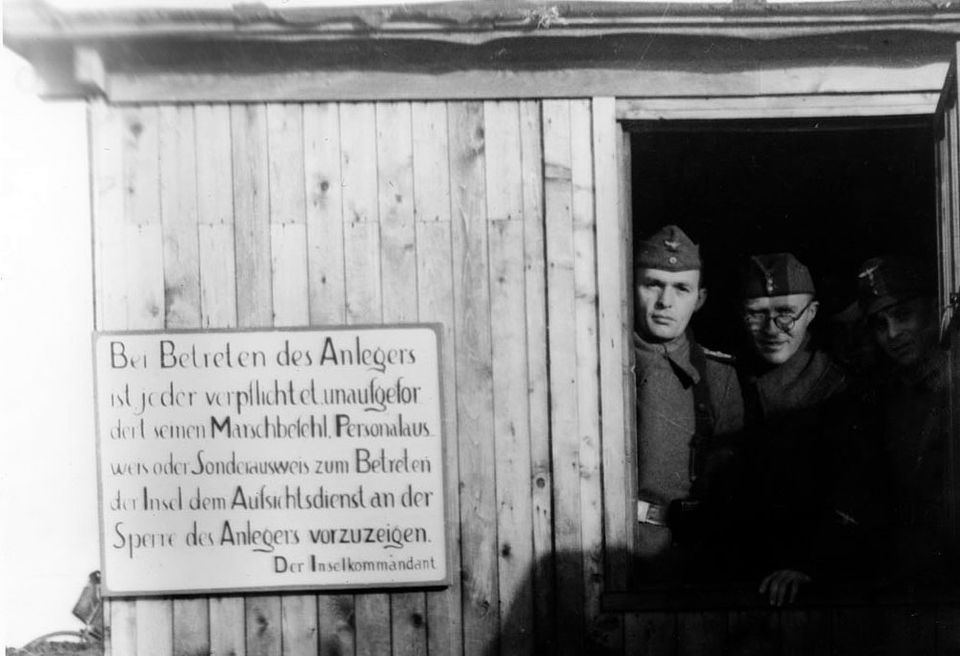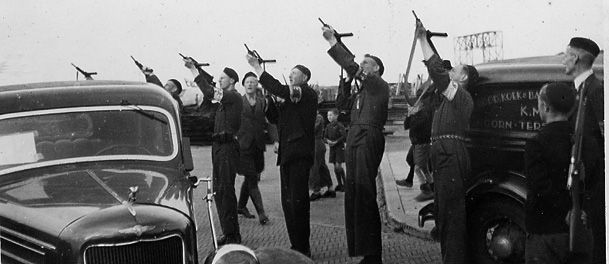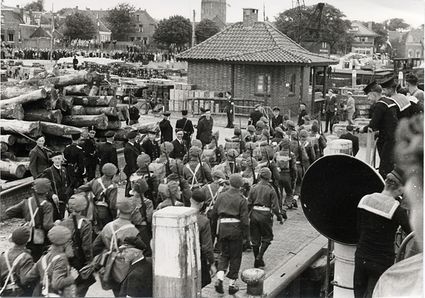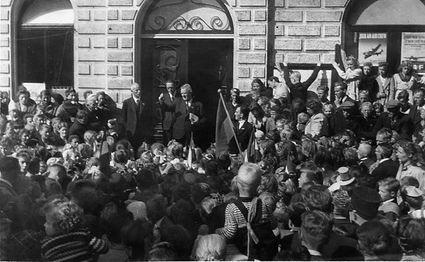Schiermonnikoog during the war years
Reading time: less than 5 minutes
The first German military men set foot on Schiermonnikoog on 15 May 1940. Thirty men from the navy and the Heer (the Wehrmacht land forces) crossed over from the nearby East Frisian Wadden island, Borkum. They immediately began building a radar station northeast of the village and a narrow-gauge railway to transport building materials arriving by sea and to be used for coastal defence. Occupation was a fact when the German flag was raised near the Schiermonnikoog lighthouse. More than seven hundred men came to the island, mainly from the navy and air force. That was almost as many as the eight hundred residents Schiermonnikoog had at the time.
On 15 May 1940, the first German military men marched through the village of Schiermonnikoog.
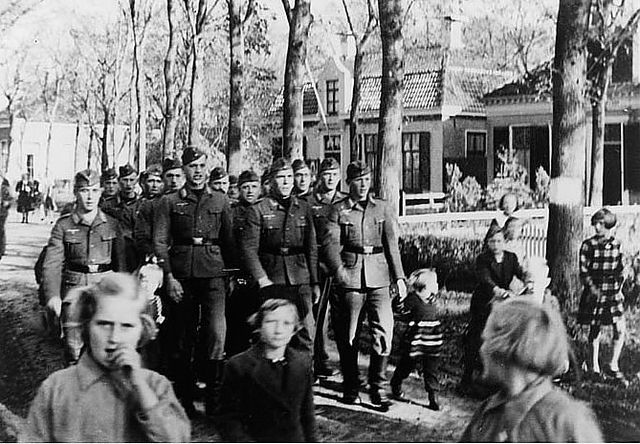
Atlantic Wall
Just like on the other Wadden islands, construction of buildings as part of the Atlantic Wall also began on Schiermonnikoog. Bunkers were built in the dunes along the beach and at the end of the Prins Bernhardweg an entire village emerged, called, ‘Schlei’, that consisted of bunkers, radar installations, camouflaged barracks and anti-aircraft artillery. A Wassermann radar antenna was meant to be installed in one of the bunkers, but that never occurred. Instead, a small bunker with a smaller type of antenna was built just outside the village that was used as a communication centre.
Mobilisation and surrender
After the Netherlands had announced the mobilisation, a small group of men from the island left for the mainland on 28 August 1939. In the opposite direction, the Dutch military on Schiermonnikoog were billeted. That did not lead to acts of war. The first German military men came to the island on the same day as the Netherlands surrendered as a reaction to the bombing of Rotterdam, 15 May 1940. Later that year, island residents were confronted with the violence of war. On 2 August 1940, the remains of eighteen French soldiers killed in the Battle of Dunkirk in northern France washed up on shore. They found their final resting place in the ‘Vredenhof’ cemetery.
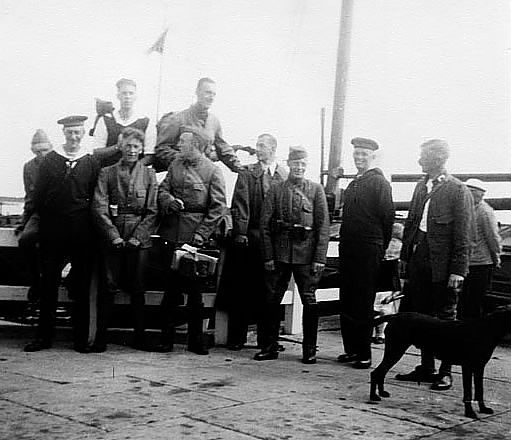
Occupation
There were more than seven hundred German soldiers on the island during the occupation, compared to the eight hundred residents. Just like all the other Wadden islands, an Inselkommandant was appointed to Schiermonnikoog. Together with Ameland, the island fell under the command of the (Küstenbefehlshaber in der Deutschen Bucht) (Naval Commander in the German Bight). In June 1943, both islands came under the command of the Dutch division of the German Wehrmacht.
Isolation
The occupation brought tourism to a halt in the summer of 1940. Without a special pass, no one from the mainland was allowed on the island. The residents were isolated in and around the village on a small part of the island. The largest part of Schiermonnikoog was a restricted area and only accessible to labourers who worked building the fortifications for the Germans. Because there was a lot of work to be done, most of the men on the island avoided being sent to Germany for forced labour. Their contribution to the fortifications compensated in part for the loss of income from tourism.
The Fortifications
With the paid efforts of the islanders, the Germans built military bunkers in the dunes, along the beach and an entire village, ‘Schleistelling’, at the end of the Prins Bernhardweg. It consisted of bunkers, radar installations, anti-aircraft artillery and barracks. The artilleries from the heavy anti-aircraft battery in the dunes on the north-western part of the island, built for coastal defence, were occupied by men from the German navy. The Schleistelling, on the eastern side of the island, was occupied by soldiers from the air force.
The Schleistelling
The heart of the ‘bunker village’ was a Wassermann radar bunker (L 480) that was built during the Winterausbauprogramm of the Atlantic Wall (1942/1943). It was the only sturdy bunker made of reinforced concrete on the island. The planned 60-metre high Wassermann antenna mast was never installed. The diameter of the opening was too small. As a replacement, a Wassermann M IV was installed on a smaller foundation nearby. In addition to this sturdy bunker, the Schleistelling also had a large number of lighter bunkers to protect against shrapnel, including a special building for analysing measurement data.

Liberation
On 15 April 1945, when Canadian and German troops were still fighting heavily for the city of Groningen, 125 members of the German intelligence service (SDers and SSers) managed to escape from the feared Scholtenhuis. Many of those arrested during the war were tortured and died during their incarceration here. The men fled in boats over the Wad from Groningen to Schiermonnikoog, where they were less than welcome. Island commander Wittko allowed them to camp out in the kooiboerderij, far away from the village. He was apprehensive of problems due to the extremely bad reputation of the SD and SS officers and, just to be safe, he had cannons aimed at the kooiboerderij. However, the SD and SS officers sabotaged the cannons as soon as they arrived, which shows just how tense the internal relationships were among the German military men.
Tense relationships
When the Netherlands was officially liberated, the island commander on Schiermonnikoog refused to give up. The island was forced to endure an even stricter regime than the entire previous period of the war. The tense relationships between the Wehrmacht military men and members of the SS and SD made life even more difficult for the islanders. At the same time, the island commander wanted to try to recapture the German fortifications on Oostmahorn from the Canadians. This finally resulted in firing from the mainland, and the islanders having to run for cover.
Celebration
On 25 May 1945, the first Canadians arrived on the island. The men who had escaped from the Scholtenhuis in Groningen to Schiermonnikoog were taken away on 31 May. Although the German occupying forces were still present on their island, the Schiermonnikoog residents held their liberation celebration on 1 June 1945. On 11 June, the German military men were taken to Germany by ship via Oostmahorn and the final piece of the Netherlands was liberated.
All traces of the anti-aircraft battery have been lost. Only the foundations are still visible, and several bunkers lie hidden under the sand. Bunkers are still visible at the Schlei fortification. One of the preserved buildings houses a Bunker Museum.
The Wassermann bunker is situated at the highest point, slightly land inwards, along the Prins Bernhardweg that leads to the Bunker Museum. The Wassermann bunker is free to visit and offers a beautiful view of the area form the roof.
Visit Schiermonnikoog
